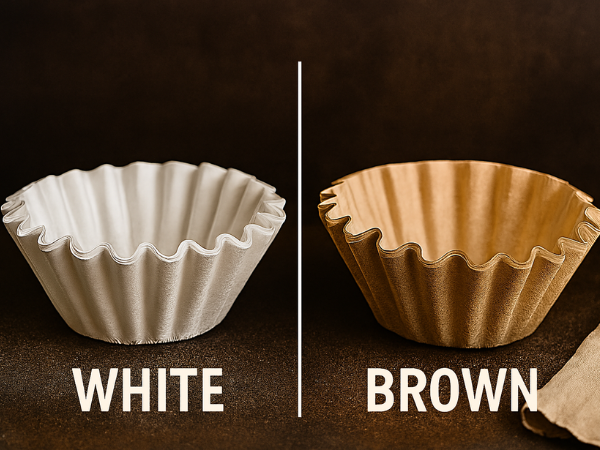At first glance, white and brown filters may seem identical in function, but their processing and impact on flavor, sustainability, and brewing experience set them apart.
From the way they’re made to the subtle notes they can add—or remove—from your brew, filter choice can influence more than you might expect.
What Are White Coffee Filters?
White coffee filters are made from paper that has been bleached to remove its natural brown color. The bleaching process can be done with chlorine or, more commonly today, with oxygen‑based methods that are safer and more environmentally friendly.
Key points about white filters:
- Appearance: Bright white, uniform look.
- Processing: Bleached with chlorine or oxygen.
- Flavor impact: Designed to be neutral, minimizing paper taste.
- Availability: Widely sold in most grocery stores.
White filters are popular because they look clean and are often marketed as producing a “purer” cup, though the difference is subtle for most drinkers.
What Are Brown Coffee Filters?
Brown filters are unbleached paper filters that retain their natural color. They skip the whitening process, making them appealing to eco‑conscious coffee drinkers.
Key points about brown filters:
- Appearance: Natural brown, slightly rustic look.
- Processing: No bleaching; less chemical treatment.
- Flavor impact: May impart a mild paper taste if not rinsed.
- Availability: Common, but sometimes less stocked than white filters.
Many people choose brown filters for their eco‑friendly image, though a quick rinse with hot water before brewing helps remove any papery flavor.
How the Bleaching Process Affects White Filters
The main difference between white and brown filters lies in how they’re processed. White filters undergo bleaching, while brown filters do not.
Bleaching methods used:
- Chlorine bleaching: Older method, less common today.
- Oxygen bleaching: Modern, safer, and more environmentally friendly.
Impact on coffee:
- Minimal effect on taste when rinsed properly.
- White filters are often preferred in professional settings for consistency.
In practice, the bleaching process doesn’t significantly change the flavor of your coffee, but it does influence perception and appearance.
Do Brown Filters Impact Flavor in the Cup?
Some coffee drinkers notice a difference when using brown filters, especially if they skip rinsing. The natural fibers can release a faint papery taste.
Ways to reduce flavor impact:
- Rinse the filter with hot water before brewing.
- Use freshly ground beans to overpower subtle paper notes.
- Opt for higher‑quality brown filters with tighter paper weave.
For most people, the difference is minor, but sensitive palates may prefer white filters for a cleaner taste.
Environmental Considerations: White vs. Brown Filters
Sustainability is a big factor in the filter debate. Brown filters are often seen as more eco‑friendly, but the reality is more nuanced.
Environmental factors to consider:
- Brown filters: Skip bleaching, but still require paper production.
- White filters: Oxygen‑bleached versions are relatively safe for the environment.
- Composting: Both types are compostable if uncoated.
- Reusable alternatives: Metal or cloth filters reduce waste entirely.
Ultimately, both white and brown filters can be eco‑friendly if disposed of properly, but reusable options are the most sustainable choice.
Cost, Availability, and Brewing Performance Compared
When it comes to price and performance, both filter types are fairly similar.
| Factor | White Filters | Brown Filters |
|---|---|---|
| Cost | Usually inexpensive | Similar price, sometimes slightly higher |
| Availability | Widely available in most stores | Available, but fewer options |
| Performance | Consistent, neutral taste | May need rinsing to avoid paper taste |
In everyday brewing, the choice often comes down to personal preference and what’s easiest to find at your local store.
Which Coffee Filter Should You Choose?
Choosing between white and brown filters depends on your priorities.
Quick tips for choosing:
- Pick white filters if you want a clean, neutral brew with no prep.
- Pick brown filters if you prefer less processing and don’t mind rinsing.
- Consider reusable filters if sustainability is your top concern.
At the end of the day, both filters brew a great cup of coffee. The difference is subtle, so it’s worth experimenting with both to see which fits your taste and values best.

